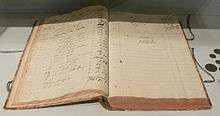General journal
| Accounting |
|---|
 |
|
Major types |
|
Selected accounts |
|
People and organizations
|
|
Development |
|
|
The journal is where double entry bookkeeping entries are recorded by debiting one or more accounts and crediting another one or more accounts with the same total amount. The total amount debited and the total amount credited should always be equal, thereby ensuring the accounting equation is maintained.[1] In accounting and bookkeeping, a journal is a record of financial transactions in order by date.
A journal is also named the book of original entry, from when transactions were written in a journal prior to manually posting them to the accounts in the general ledger or subsidiary ledger. Manual systems usually had a variety of journals such as a sales journal, purchases journal, cash receipts journal, cash disbursements journal, and a general journal. Depending on the business's accounting information system, specialized journals may be used in conjunction with the general journal for record-keeping. In such case, use of the general journal may be limited to non-routine and adjusting entries.
A general journal entry includes the date of the transaction, the titles of the accounts debited and credited, the amount of each debit and credit, and an explanation of the transaction also known as a Narration.
See also
References
- ↑ Jerry J. Weygandt; Paul D. Kimmel; Donald E. Kieso (4 May 2010). Accounting Principles, Peachtree Complete Accounting Workbook. John Wiley & Sons. p. 60. ISBN 978-0-470-38667-5. Retrieved 6 April 2012.